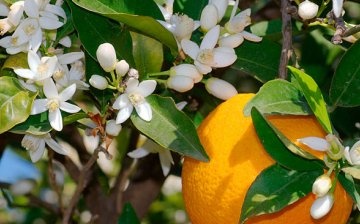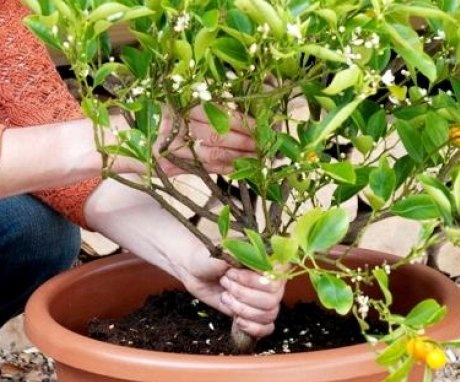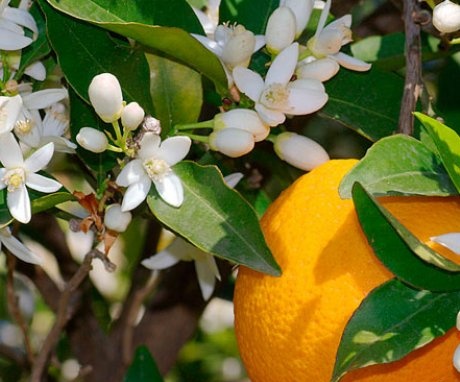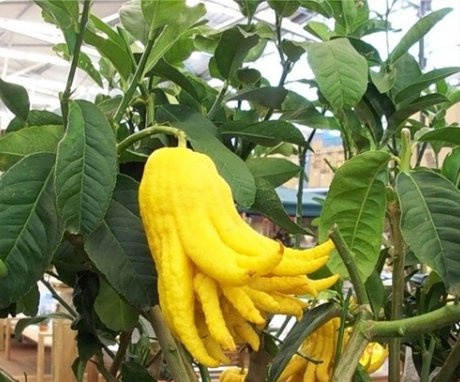The most popular indoor citrus plants: species and their cultivation
Citrus crops originated from Southeast Asia: in the tropical zone it is warm almost all year round, only in winter there is a slight decrease in temperature, in addition, the plants are constantly in conditions of good light and high humidity. It is quite difficult to create ideal conditions for indoor citrus plants at home, but it is possible: with the right leaving they will become a real decoration of the windowsill and will even bear fruit several times a year. What are the features of the citrus content, and what are the most common crops?
Content:
- Features of growing citrus at home
- Growing indoor tangerines
- Growing oranges
- Calamondin at home
- Growing a grapefruit at home from a bone
- Growing citron
Features of growing citrus at home
Almost all citrus crops are thermophilic - they need a constant high temperature, and they absolutely do not tolerate even minor frosts. Almost all citrus fruits are characterized by uneven growth: after a short period of dormancy in winter, they begin to give young shoots, and during the growth period you can expect flowering.
Many indoor citrus crops are capable of blooming several times a year.
However, in winter, it is advisable to lower the room temperature a little: since the length of the sunny day decreases, the plant suffers from a lack of sunlight. Due to the large energy losses, it will look depleted, leaf fall is often observed. In order to avoid unnecessary energy consumption, it is necessary either to provide additional artificial illumination of the required spectrum, or to lower the temperature in the room.
Citrus indoor crops have several more cultivation features:
- All of them are very fond of sunlight - it is recommended to place them on the south and east windows. If you want to plant citrus fruits in the greenhouse, they should be well lit, you can plant them in the partial shade of other plants. Lack of light quickly depletes the plant, and it can die.
- The optimum temperature of the content is +18 degrees with an air humidity of up to 70%. It is difficult to provide such conditions in the room, therefore the plant is desirable regularly spray warm water. Without a seasonal drop in temperature and a dormant period, citrus fruits live no more than 3-4 years, so they need to be harvested from November to February for the winter.
- Citrus fruits love water: watering should be regular and abundant. However, in order to prevent root rotting, it is necessary to let the soil dry out between waterings, and during the dormant period, the plant is watered no more than once a week.
These are just the basic rules for growing citrus fruits. on the windowsill, each culture has its own specific requirements for the content. Let's take a closer look at the most common citrus indoor plants.
Growing indoor tangerines
Indoor tangerines can be dwarf or common varieties: this plant has long been used for growing in a greenhouse and on a windowsill. Mandarin can be grown in the form of a bonsai - this is a special technology for forming a dwarf bush, which allows you to get a miniature tree that will bloom and bear fruit.
Mandarin is popular for its beautiful green leaves, white flowers with a pleasant smell, and fragrant fruits that can hang from the branches for several months.
The fruits of indoor tangerine have only decorative value: they are not worth eating because of their too sour taste. Improving the taste of mono fruit through selective work with several plants, however, it will take a very long time to develop a new variety. Taking care of indoor tangerine is not too difficult, you need to comply with several basic requirements:
- Regular but not excessive watering... The more leaves a plant has, the more actively they evaporate moisture, the required amount of water depends on this. In the conditions of an apartment, a mandarin is desirable regularly spraysince the plant suffers from constantly dry air.
- Regular feeding with mineral soluble fertilizers... Mandarin especially needs a lot of nutrients in the spring, before starting flowering - during this time watering fertilizer solution 1-2 times a week. Do not exceed the dosage: a large dose of fertilizers cannot be absorbed by the plant, and they can destroy root system.
- Crown formation... If you purchased not a room, but a regular variety. The growth of several large branches should not be allowed: their tips are regularly pinched in order to achieve the appearance of lateral processes.
- On young plants, flowers and ovaries need to be controlled: the fewer fruits the plant has, the larger they will be, so excess ovaries must be removed in time. First, only one ovary is left, the next year the number of fruits can be increased.
Constant care will make the tangerine strong and beautiful: it will decorate your home with dense foliage and gorgeous orange fruits with a pleasant smell. Growing a tangerine on a windowsill does not require much hassle: adherence to the basic principles of care will already allow you to quickly achieve good growth.
Growing oranges
At home, an orange can be grown from a seed obtained from the most common commercial fruit. In nature, this plant is a medium-sized tree up to 7 meters high, indoor orange can reach 3 meters in height. It can be grown not only with seeds, but also cuttingsif someone you know already has an adult plant at home.
When planted with seeds, an orange begins to bloom and bear fruit not earlier than after 7-10 years, growing a plant from a cuttings is much faster.
The conditions for growing a homemade orange are approximately the same as for other citrus crops: the plant needs a lot of light, regular watering and feeding, however, it is undesirable to loosen it often - this can seriously damage the roots.
In growing an orange from a seed, you need to follow the correct sequence of actions:
- For landing a mixture of peat with fertile soil is required, it is placed in small pots. For planting, it is advisable to take seeds from several fully ripe fruits, the seeds must have the correct shape.
- They are planted in the soil at a distance of 5 cm from each other, the depth of planting seeds is about 1 cm. After about two weeks, sprouts will appear.
- Of all the sprouts, only the strongest should be left. A mi-greenhouse is equipped for them: the plants are covered with a glass jar to ensure sufficient temperature and humidity under it. To ensure ventilation, the can must be removed for half an hour every day.
- As soon as the sprouts have a few true leaves, they are transplanted into separate pots and placed on a well-lit windowsill. Repeated transfer it will be required when the plant height reaches 20 cm, from about this time it will already be necessary to form a crown.
As with the homemade tangerine, the fruits of the indoor orange are predominantly decorative. When propagated by seeds, due to cross-pollination, the fruit will not be the same as that of the parent plant. When growing oranges in greenhouses, breeders choose seeds from the sweetest and tastiest fruits in order to pass such qualities on to the next plant in inheritance, but this is a long and long-term work.
It is better not to transfer a home-made orange from place to place; it can react to changing conditions by dropping its leaves. For him, a spacious, well-lit window sill is immediately chosen and conditions for stable good growth are provided.
Calamondin at home
Calamondin is a dwarf citrus tree that most resembles a small mandarin with bright, small fruits. Its advantage is its small size: it is easy to find a place for such a plant on the windowsill, and at the same time you do not have to worry about regular pruning crowns. Calamondin requires approximately the same conditions as other citrus fruits, but still there are several important nuances in its cultivation.
Calamondin is a light-loving houseplant, but it loves not direct, but diffused sunlight.
In summer, it feels comfortable on the southern and eastern sides; in winter, it can be transferred to the windowsill on the north side of the house. If there is not enough light for calamondin, it will grow very slowly without flowering or fruiting. In the summer months, it can be taken out into the fresh air, it can be put in partial shade for a while.
The plant requires regular abundant glaze in the summer months, and in the winter it is sufficient to water it once a week. For wintering, it is advisable to move it to a cool room - the dormant period helps the plant to restore strength and prepare for new flowering and fruiting.
Calamondin reproduces in two main ways - seeds and cuttings... Seed reproduction is too long a way, fruiting will have to wait for several years. You can propagate the plant much faster using cuttings, this work is carried out as follows:
- Cuttings are young shoots, on which at least 2-3 buds must be present. They are cut from an adult plant and placed in a nutrient solution for a while.
- When the cutting has its own young roots, it is transplanted into the ground. The optimal soil mixture consists of peat and flower soil, they must be mixed well in a 1: 1 ratio.
- The handle is covered with a glass jar to create mini greenhouses with high temperature and humidity. To change the air in a mini-greenhouse, the jar needs to be cleaned once a day for half an hour.
- As soon as the cuttings have their first leaves of their own, the jar can be removed, after which the calamondin is grown as a regular indoor citrus plant.
With proper care, the plant will bear fruit every year, the bright fruits look beautiful among the thick dark green leaves. Do not eat pods, they will turn out to be too sour or even bitter.
Growing a grapefruit at home from a bone
Growing grapefruit at home is not as difficult as it might seem. With the right crown formation the height of the plant in indoor conditions does not exceed 1.5-2 meters, it will look very beautiful thanks to the dark leaves on especially curved petioles. Indoor grapefruit varieties are capable of producing juicy and quite tasty fruits, and their weight can reach 400 grams.
Grapefruit is a light-loving plant, it needs enough sunlight and free space.
It is suitable for growing not only in an apartment, but also in an office, in a greenhouse or on an insulated loggia. Grapefruit does not like cold weather, even short-term frosts can cause serious harm to it, so you can keep it outdoors only in the summer months.
Watering the plant:
- Grapefruit requires regular watering during the warm season, while the water should not stagnate in the pot - equip the bottom with a drainage layer of expanded clay.
- To ensure normal air humidity, the plant must be constantly sprayed with a spray bottle.
- In winter, the plant is removed to a room with a lower temperature and less illumination; during the dormant period, it is enough to water it only 2 times a month.
Young plants are transplanted annually, for adult grapefruits transfer with the replacement of the soil substrate should be carried out at least once every 5-6 years. During active flowering and fruiting, the plant is fed with a complex mineral fertilizer, for example, "Rainbow".
Grapefruit is the best option for seed growing at home. Ordinary seeds from mature fruits germinate quickly and take root well, the plant can begin to bear fruit as early as the fourth year if comfortable conditions are created for it. It is important to provide him with a sufficient amount of sunlight: if there is not enough illumination, growth slows down and a curvature of the trunk is observed. If it is not possible to put the plant on the southern or eastern windowsill, you need to purchase a special fluorescent lamp for indoor flowers. Care and maintenance will result in regular fruiting and beautiful, abundant flowering.
Growing citron
Citron is a rarer citrus plant; it is grown indoors only for its decorative qualities. Citron has large yellow fruits that look beautiful against the background of dark green leaves. In indoor conditions, the plant reaches a height of 1.5 meters.
The most interesting decorative variety is the finger citron - it is also called the "Buddha's Hand".
It is interesting for the unusual shape of the fruit - outwardly, they most of all resemble a bunch of bananas. Such a citron begins to bear fruit already in the third year after planting. This plant is among the light-loving, even during the dormant period, it should be in a well-lit room. In summer, citron needs abundant regular watering, with dry indoor air, it is placed in a pan with water or regularly sprayed with a spray bottle.
Citron can be planted seeds and seedlings: the first option is longer, the fruits will have to wait for more than 5 years. When breeding cuttings it is possible to get a plant that completely copies the parental traits, you can plant a citron at home with the largest and most fragrant fruits. It is not difficult to grow citrus fruits at home, and they will quickly turn into one of the main decorations of the windowsill. Providing good conditions, any citrus plant will quickly bloom and bear fruit.
More information can be found in the video.























I tried to grow a lemon from a seed, but I never got any fruit. One tree began to disappear after 3 years, while the other survived for 10 years. Perhaps the growing conditions were inappropriate. The crown was sprayed, quite rarely, and fertilizers were applied irregularly.